These homemade shampoo bars will naturally nourish and strengthen your hair! Most salon or store-bought shampoos are expensive and full of chemicals. Try this easy and affordable shampoo recipe that is perfect for travel and so much fun to make!
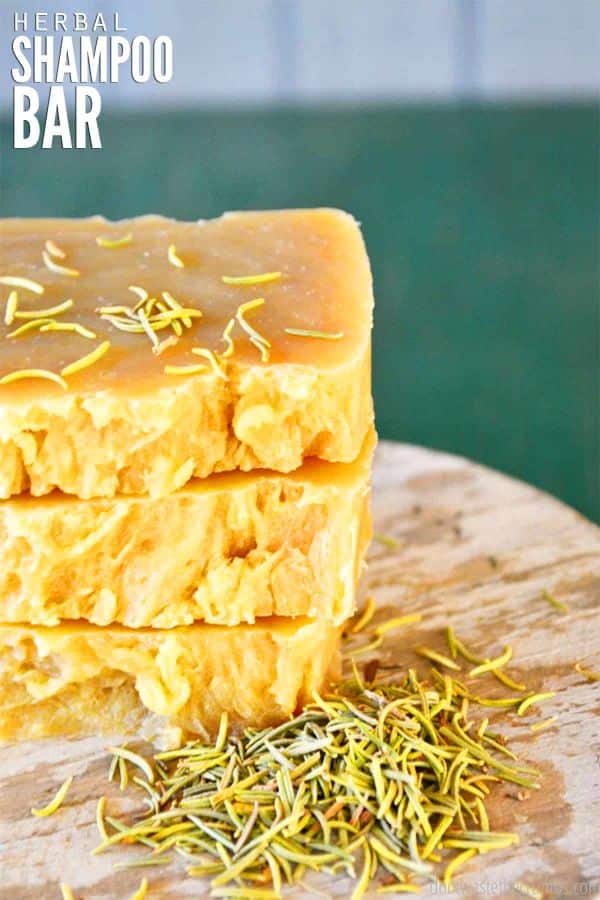
Our skin is our largest organ, and it will absorb what we put on it. There are many toxins that we can’t control, so it’s important to limit the ones we can.
Most of the shampoos and soaps on the supermarket shelf are full of chemicals. They may make your hair sparkle and shine, but what is the long term effect of those chemicals on our bodies?
I don’t want to take the risk to find out, so I decided to make homemade shampoo bars. I love using them because they are:
- Nourishing. Aloe vera oil, jojoba oil, and castor oil are excellent for keeping your hair silky and soft with enough moisture to keep it from drying out.
- Hair strengthening. Herbs such as rosemary, sage, nettles, and arnica are really good for hair growth and strength.
- Made using a hot process soap-making method. I prefer it over the cold process, since you can use the bars right away. Cold process soap has to cure for about 4 weeks to reach neutrality.
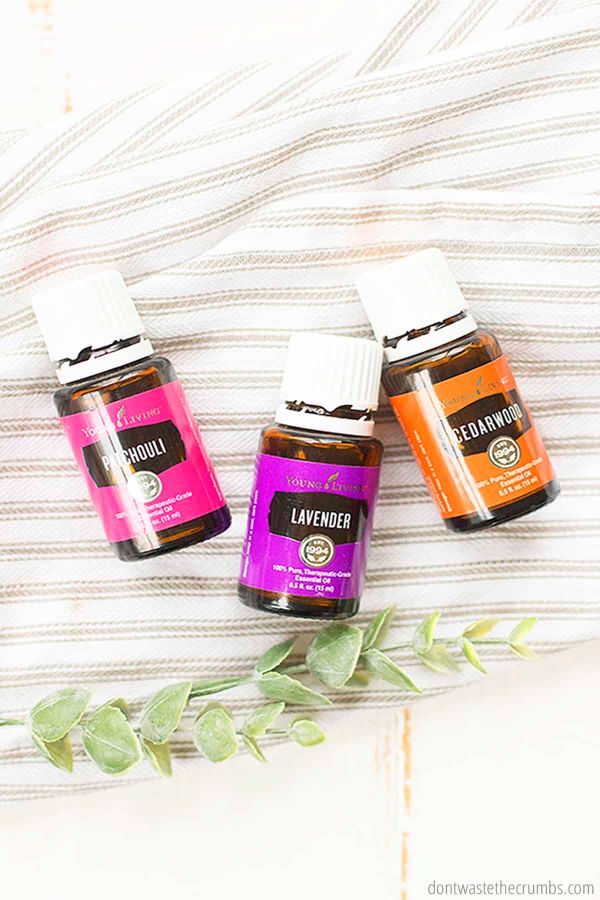
Here’s What You Need for Shampoo Bars
- Dry herbs (rosemary, sage, nettles, arnica, etc.)
- Water
- Lye (Sodium Hydroxide)
- Coconut Oil
- Olive Oil
- Avocado Oil
- Castor Oil
- Aloe Vera Oil
- Jojoba Oil
- Coconut milk
- Essential oil of your choice** (optional, I like to mix orange and peppermint, rosemary and lavender, or single oils like eucalyptus, cedarwood, and lemon). I use Young Living oils and HERE is why. However if Young Living is out of your reach, I’ve heard great things about Plant Therapy on Amazon.
- Kitchen scale (optional, but very helpful)
- Protective eyewear (glasses or light shade sunglasses work great)
- Rubber kitchen gloves
- Crock-pot (there is almost always one at a thrift store)
Note on Ingredients
- Lye. Lye is a caustic substance and needs to be handled carefully. Wear protective eye wear and long sleeves and gloves while making these homemade shampoo bars. Always make sure to pour the lye into the water and not the other way around. It could cause a small explosion! As long as you are careful with handling it you shouldn’t have any problems. This part of soap making is definitely something to do while the kids are otherwise occupied.
Step-by-Step Instructions
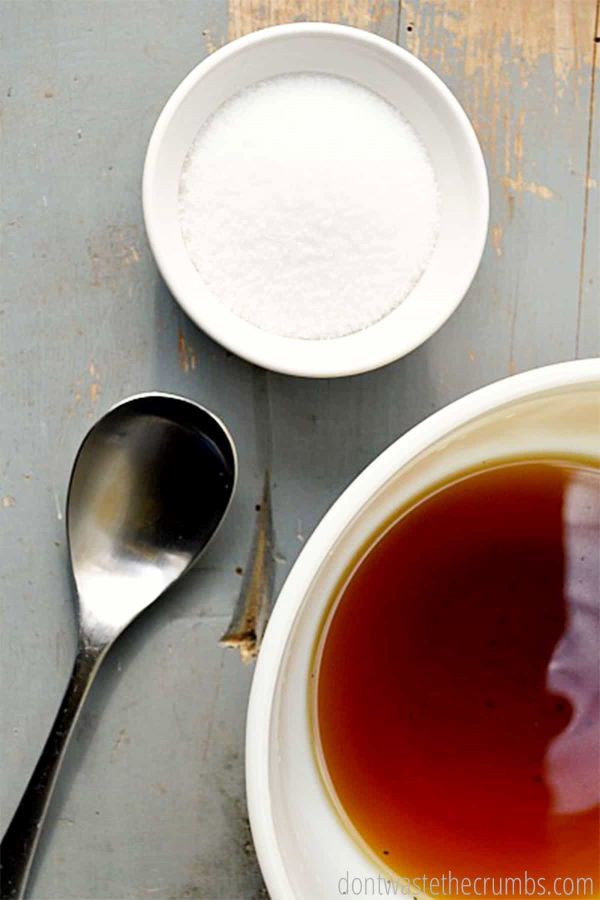
Step 1. Plan ahead by a couple of hours because you need to infuse your water with herbs. Heat your water just to boiling and pour into a glass jar. Add in your choice of herbs and screw on the lid. Let rest for at least two hours so the water will pull out the nutrients and scent from the herbs.
Step 2. Once the water is infused, re-measure it into a large heat proof bowl and add more water if necessary.
Step 3. Wearing gloves and eye protection, measure your lye into a separate dish. Take your water and lye outdoors to mix; they throw off some strong fumes! Add your lye into the water stirring as you pour.
Step 4. Leave the lye mixture outside to cool slightly while you start on the next step.
Step 5. Place the dish that contains the lye into the sink and fill with soap and water and let it soak. You will want to make sure and wash it wearing your gloves.
Step 6. Measure your oils (minus the essential oil if using) into a crock pot and heat on low. Be sure to get accurate measurements to ensure proper neutralization through the saponification process. (This step may take a while depending on the temperature of your home. Soap making is much quicker in summer when the coconut oil is already soft, but you can easily step away for a minute if you need to while the oils melt.)
Step 7. Once the oils are melted, it’s time to add in the water/lye mixture. Wearing your gloves and eye protection again, stir the water/lye into the oils. Place your large bowl in the sink with the other lye dishes to wash when you are done.
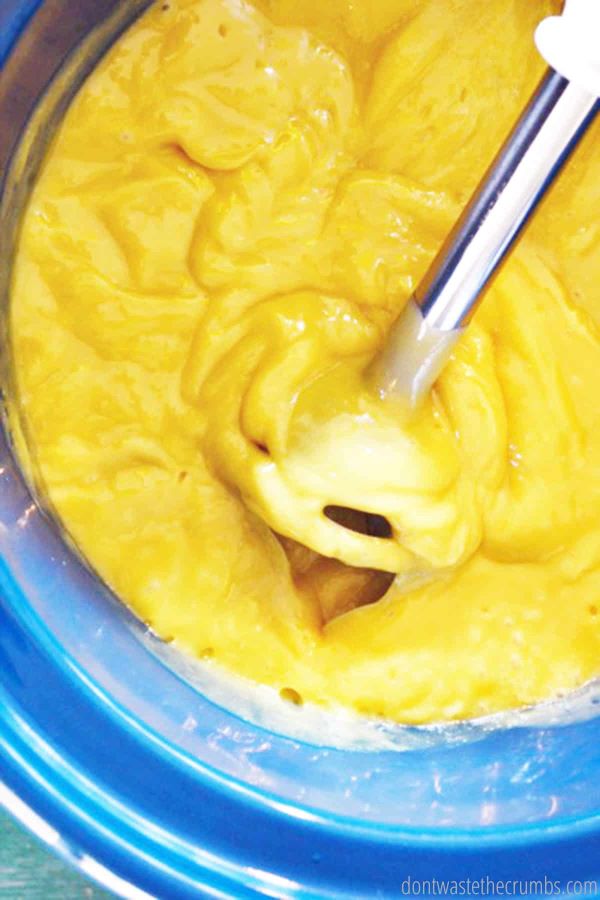
Step 8. You need to mix the oils and water/lye mixture to “trace.” This is where the shampoo starts to saponify (making the soap into soap!). The best way to mix it to trace is to use an immersion blender, otherwise you will be stirring by hand for quite some time. However, you CAN use either method, and you should stir or blend until the shampoo looks like pudding.
Step 9. Stir in the coconut milk. This adds a really nice texture to the homemade shampoo bars and nourishes the scalp.
Step 10. Cover the crock pot and let cook for about an hour for the shampoo to cook and reach neutrality. If you let it go a little longer, it’s okay. You can use a pH testing strip to make sure it’s at a pH between 6 and 8 if you’re concerned about the caustic ingredients. I typically don’t and haven’t had any issues.

Using essential oils for scent and hair benefits in homemade shampoo bars
Ps…Add them in after your shampoo has cooked to neutrality. How much you add will depend on your scent preference and the strength of the oil. Keep in mind that it will smell very strong at this point, but once the soap cools the scent will dissipate some. I tend to go on the heavier side so I get a good strong scent.
Step 11. Now it’s time to put your shampoo into a mold! I use a loaf mold. You can easily use a loaf pan, mini-loaf pan, rectangle box, or even a large shallow baking dish (you will cut it differently for this shape mold). Line your mold with parchment paper or plastic wrap and scoop in your shampoo. It will be hot, so be careful. For an extra touch of pretty, sprinkle dried herbs on top.
Step 12. Next, gently wrap the mold in a towel and place in a cardboard box or warm cabinet. If it cools too quickly the shampoo bars may split on the top. Let it set for 24 hours.
Step 13. Once it has set, gently remove from the mold. Cut your shampoo into your desired size bar, but approximately one inch thick is my goal.
Using the hot-process method, the bar is at neutrality by this point so you can go ahead and use it now!
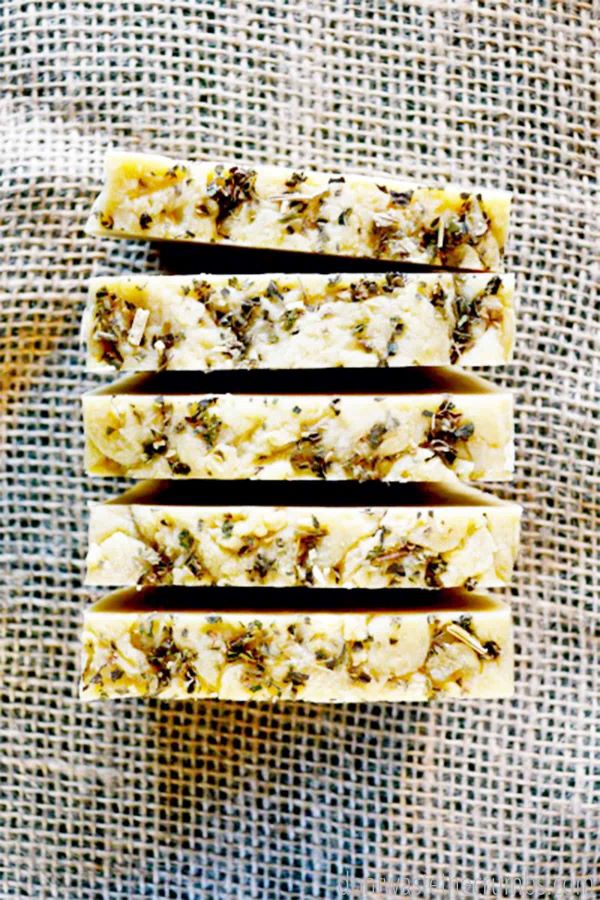
Homemade Shampoo Bar Recipe Tips
- For the rest of the homemade shampoo bars, place in a cardboard box with some space in between each for some air flow. The bars will continue to harden as time goes on. Because this recipe uses a lot of coconut and olive oil it will turn out fairly soft. You should store unused bars in a cool place.
- It is very important to have accurate measurements in soap making, as inaccuracy could cause your shampoo to be too caustic and burn the skin.
- Always add the lye to the water and not the water to the lye, which causes a very bad reaction!
- After using this homemade shampoo bar, I always follow up with a 1:3 mix of apple cider vinegar to water as a conditioner. Spray it on right before jumping out of the shower (and don’t rinse) to soften hair and give it some shine. The vinegar scent dissipates quickly.
FAQs
What can I use instead of shampoo?
I would suggest reading my article on how to wash your hair without shampoo here.
What substitutes would you recommend for coconut milk?
You can use water as an alternative for coconut milk.
Is homemade shampoo better for your hair?
This homemade shampoo bar is beneficial to your scalp and your locks will feel and look healthier!
More DIY Beauty Recipes
- Homemade powdered foundation
- DIY clay-based toothpaste (just like Earthpaste)
- Natural Makeup Remover
- Homemade facial cleanser
DIY: Homemade Herbal Shampoo Bar
These homemade shampoo bars will naturally nourish and strengthen your hair! Most salon or store-bought shampoos are expensive and full of chemicals. Try this easy and affordable shampoo recipe that is perfect for travel and so much fun to make!
Ingredients
- 1–2 Tbsp dry herbs (Rosemary, sage, nettles, arnica, etc.)
- 7 oz water
- 4.4 oz lye (Sodium Hydroxide)
- 10 oz coconut oil
- 9 oz olive oil
- 6 oz avocado Oil
- 3 oz Castor oil
- 3 oz aloe vera oil
- 1 oz jojoba oil
- 3.5 oz coconut milk
- .5-1 oz essential oil of your choice** (optional, I like to mix orange and peppermint, rosemary and lavender, or single oils like eucalyptus, cedarwood, and lemon)
- Kitchen scale (optional, but very helpful
- Protective eye wear (glasses or ligh shade sunglasses work great)
- Rubber kitchen gloves
- 4 qt crock-pot
Instructions
- Plan ahead by a couple of hours because you need to infuse your water with herbs. Heat your water just to boiling and pour into a glass jar. Add in your choice of herbs and screw on the lid. Let rest for at least two hours so the water will pull out the nutrients and scent from the herbs.
- Once the water is infused, re-measure it into a large heat proof bowl and add more water if necessary.
- Wearing gloves and eye protection, measure your lye into a separate dish. Take your water and lye outdoors to mix; they throw off some strong fumes! Add your lye into the water, stirring as you pour. Leave the lye mixture outside to cool slightly while you start on the next step.
- Place the dish that contains the lye into the sink and fill with soap and water and let it soak. You will want to make sure and wash it wearing your gloves.
- Measure your oils (minus the essential oil if using) into a crock pot and heat on low. Be sure to get accurate measurements to ensure proper neutralization through the saponification process. (This step may take a while depending on the temperature of your home. Soap making is much quicker in summer when the coconut oil is already soft, but you can easily step away for a minute if you need to while the oils melt.)
- Once the oils are melted, it’s time to add in the water/lye mixture. Wearing your gloves and eye protection again, stir the water/lye into the oils. Place your large bowl in the sink with the other lye dishes to wash when you are done.
- You need to mix the oils and water/lye mixture to “trace.” This is where the shampoo starts to saponify (making the soap into soap!). The best way to mix it to trace is to use an immersion blender, otherwise you will be stirring by hand for quite some time. However, you CAN use either method, and you should stir or blend until the shampoo looks like pudding.
- Stir in the coconut milk. This adds a really nice texture to the shampoo bars and nourishes the scalp.
- Cover the crock pot and let cook for about an hour for the shampoo to cook and reach neutrality. If you let it go a little longer, it’s okay. You can use a pH testing strip to make sure it’s at a pH between 6 and 8 if you’re concerned about the caustic ingredients. I typically don’t and haven’t had any issues. If you are using essential oils for scent and hair benefits, add them in after your shampoo has cooked to neutrality. How much you add will depend on your scent preference and the strength of the oil. Keep in mind that it will smell very strong at this point, but once the soap cools the scent will dissipate some. I tend to go on the heavier side so I get a good strong scent.
- Now it’s time to put your shampoo into a mold! I use a loaf mold. You can easily use a loaf pan, mini-loaf pan, rectangle box, or even a large shallow baking dish (you will cut it differently for this shape mold).Line your mold with parchment paper or plastic wrap and scoop in your shampoo. It will be hot, so be careful. For an extra touch of pretty, sprinkle dried herbs on top.
- Gently wrap the mold in a towel and place in a cardboard box or warm cabinet. If it cools too quickly it may split on the top. Let it set for 24 hours.
- Once it has set, gently remove from the mold. Cut your shampoo into your desired size bar, but approximately one inch thick is my goal.
- Using the hot-process method, the bar is at neutrality by this point so you can go ahead and use it now!For the rest of the bars, place in a cardboard box with some space in between each for some air flow. The bars will continue to harden as time goes on. Because this recipe uses a lot of coconut and olive oil it will turn out fairly soft. You should store unused bars in a cool place.
Notes
- It is very important to have accurate measurements in soap making. Inaccuracy could cause your shampoo to be too caustic and burn the skin.
- Always add the lye to the water and not the water to the lye. That could cause a very bad reaction!
- After using this homemade shampoo bar, I always follow up with a 1:3 mix of apple cider vinegar to water as a conditioner. Spray it on right before jumping out of the shower (and don’t rinse) to soften hair and give it some shine. The vinegar scent dissipates quickly.



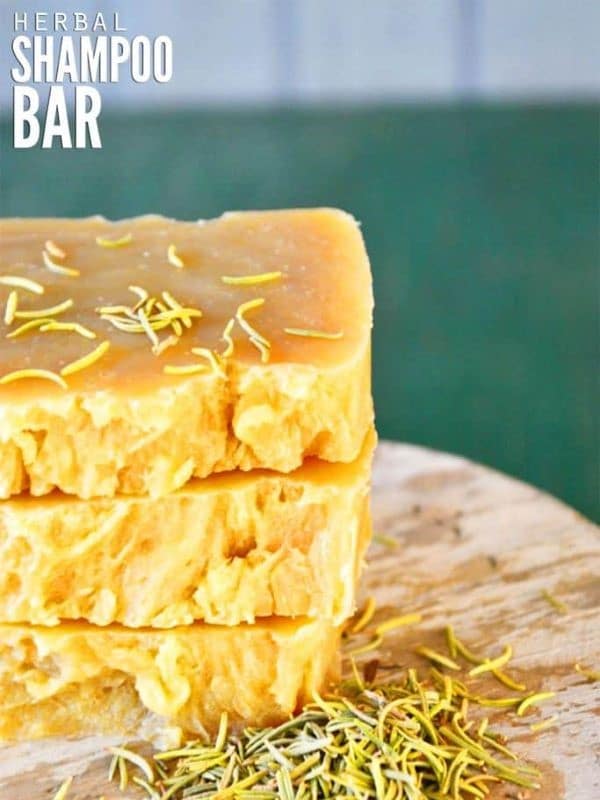

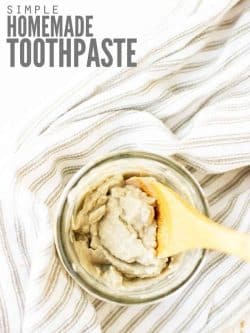
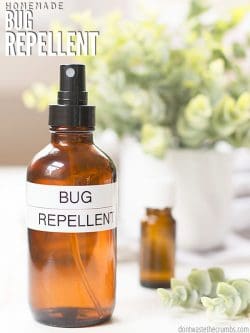
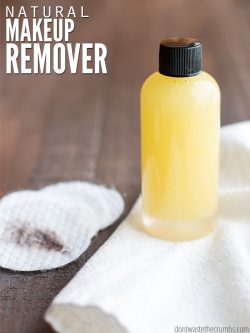

does this soap recipe have a decent lather?
Hi there, I love this recipe. I make all of my own cold process soaps. If I wanted to skip the cooking process at the end, can this recipe be used as if I were making cold process soap? Thank you, Sandy
Hi Sandy,
I am sorry, but we haven’t made cold pressed soaps using this recipe. Sorry I couldn’t help. 🙂
I am getting ready to make this shampoo. I was wondering if you could make your own aloe vera oil with aloe vera gel and coconut oil? If so, what would the proportions be?
Also, if at the end, if did use a ph strip to test neutrality, how would you fix it if not neutral?
One more question, do you have a separate immersion blender and crock pot to make the shampoo? Or do you just wash them and use them for food afterwards?
Thank you for your response.
Hello Kelly!
I’m sorry, we don’t have any experience with making our own aloe vera oil/gel or coconut oil. I’ll bet you can find a good amount of information if you google instructions on that sort of thing.
Yes, we did use a separate crockpot for the soap making.
I have heard that using citric acid can help to neutralize soap, but we don’t have experience with having to neutralize it further. If you did a google search on neutralizing soap with citric acid, I think you can find specifics on that. Thanks. Hope this helps!
Hi I was wondering if using coconut milk affects the shelf life of the soap ? I usually make cold process soaps but am keen to try this recipe
Hi Joanne,
As with anything homemade using natural ingredients, rather than chemical commercial ingredients, you’re going to have a shorter shelf life than commercial. Where a commercial soap might be good for 2-3 years on the shelf, a natural soap may last a year. Of course, if the smell of the soap changes, or it develops spots, it is no longer good. But I’d say it’s good several months to a year depending on storage conditions. Hope this helps! 🙂
I have dry, curly hair. Is there an ingredient that I should add more of to ensure there is enough moisturizing in the shampoo? I would like to create a liquid DIY shampoo. Is there A modification to make the liquid form of this shampoo?
I was wondering which soap calculator you used to calculate the lye and water content. And what is the Superfat percentage you used in this recipe. It is easier if you use percentages in the recipe instead of weight. Also what is the water: lye ratio you used or water as % of oils.
Hi Kate!
It’s been a while since I’ve made this particular soap recipe, and I honestly don’t remember the soap calculator or percentages. I recommend following the recipe as written for the best results!
What’s the temperature your suppose to cook the shampoo at. You talk about putting it in the crockpot and if it’s over a hour that’s fine. But you never said what temp to put the crockpot on.
Hi Ruby,
The crock pot temp for this recipe is high to help it melt. 🙂
Hello! Am going to try your recipe today and looking forward to it! But I also want to dry the liquid blend that you have mentioned in your introduction – the link on the same leads to neverlackingzeal.com which is a stub. Would you be able to guide me on how to access that recipe please. Many thanks, Nina
Hello. Your recipe sounds very exciting! Would you be able to suggest on an alternative for Aloe Vera oil please. Thanks